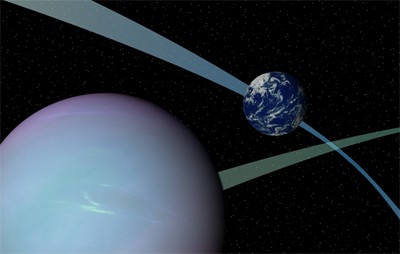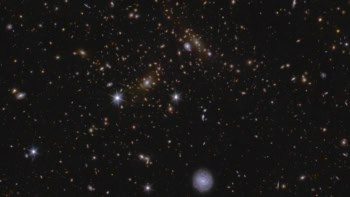
Planets that pivot between different degrees of obliquity might be unexpected candidates for extraterrestrial life, according to researchers from the US. Kept in flux by the gravitational pull of nearby gas giants, these wobbling worlds periodically point their poles towards their host star, staving off a scenario where the exoplanet is frozen if it is at a considerable distance from its parent star.
Tilted shifts
In the past, researchers have detected Earth-sized exoplanets that have extremely inclined orbits, especially when compared with planets in our solar system. A combination of torque from the host star and the gravitational influence of a nearby gas giant causes the smaller exoplanets to wobble back and forth. These periodic shifts would drastically vary the axis of rotation of the exoplanet across geologically short timescales, and it was thought that such planets would be unsuitable for life to exist. Astrobiologists looking for habitable exoplanets study the region around a star in which terrestrial planets could support liquid water on their surfaces, known as the “habitability zone”, the size of which is usually determined by a number of variables such as the orbital radius, planetary mass and host-star brightness.
In the new work, a team led by John Armstrong from Weber State University studied whether such tilted worlds could also host life, thereby extending the habitable zone in such systems. The team simulated 17 hypothetical exoplanetary systems – each containing one Earth-like planet orbiting at 1 AU, and one or two gas giants.
Frozen worlds?
What the team’s simulations showed was that climate effects generated on these tilted planets might prevent them from being over-run by ice, even if those planets are somewhat far from their stars, falling outside of the normal habitable zone. Such a global-scale freezing scenario is normally thought to be assisted by the ice-albedo feedback, in which expanding, light-coloured glaciers increase the amount of heat reflected back to space, thereby bringing about further cooling.
“Rather than working against habitability, the rapid changes in the orientation of the planet could turn out to be a real boon sometimes,” says Armstrong. The team’s modelling showed that the feedback was suppressed because the periodic tilting of the poles towards the host star allowed greater levels of inbound radiation to reach the polar regions, melting the planet’s glaciers. Such bodies could therefore be almost twice as far from their star as the Earth is to the Sun, and still have liquid water on their surfaces.
Alien climates
“This work clearly demonstrates that as astronomers begin to detail the mechanics of planetary systems, we’re also getting our hands on vital clues to the workings of alien climates, and that magical thing we call ‘habitability’,” says Caleb Scharf, an astrobiologist at Columbia University, who was not involved in this study.
The researchers claim that their study has shown how “orbital architecture” is a crucial factor when assessing planetary habitability. With their initial simulations complete, Armstrong and colleagues are now looking to apply their model to known planetary systems to better assess their habitability, so that they can help identify planets worthy of being spectroscopically studied.
“Although it has long been thought that our planet presents a ‘Goldilocks scenario’ for life, it is becoming apparent that this belief might stem from a myopic view of what kinds of conditions life would thrive in,” says Dave Spiegel, an astrophysicist at the Institute for Advanced Study, who was also not involved in the new study. However, Spiegel cautions that “high obliquity might still pose a serious risk to complex, land-based life.” Planets with wildly varying tilts might experience extremely hot surface temperatures – of around 100 °C – on near-polar continents during periods of high obliquity, meaning that life might only exist in the oceans, where longer thermal timescales can buffer changing temperatures.
The research is described in Astrobiology.
-
-
- Find out more about how astronomers hunt for exoplanets in the video below.
-



